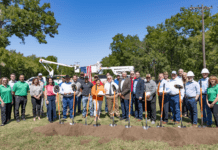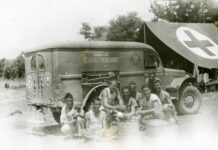A century ago, pedestrians and the occasional horse-drawn conveyance ruled the streets. Therefore, the largest metropolitan areas in Oklahoma were laid out accordingly – to maximize pedestrian considerations. But the introduction of automobiles into everyday life brought about a lot of change that would have long-lasting effects.
“Automobile ownership became the natural way that people got around,” says Justin Henry, transportation program planner with the City of Oklahoma City. “We really shifted away from that pedestrian planning for a long time.”
Designing streets and neighborhoods for car traffic began to take its toll, and in recent years, there has been a shift back to the idea of making both Oklahoma City and Tulsa more walkable.
“We have done more sidewalk construction probably in the last ten years now than we did in the previous fifty,” says Henry. “So we’re really trying to invest in it in a big way and move forward.”
Terry Ball, director of streets and stormwater for the City of Tulsa, describes making a city more “walkable” as helping people get from point “a” to point “b” safely. Whether you want to go to the library or the grocery store and whether you are on foot, a bicycle or scooter, walkability can include various means of transportation, just minus the car, he says.
Walkability isn’t an on/off switch either; it’s a gradient of amenities, says Henry. It includes things like proper lighting, street furnishings such as benches or water fountains, landscaping elements like shade trees, and even the placement of buildings and other land uses near walkable streets and sidewalks.
In 2018, Oklahoma City’s city council adopted BikeWalkOKC, the bicycle and pedestrian master plan. This plan directs priorities for spending on sidewalks, bike lanes and street enhancements (a catch-all term for those higher level aspects of walkability), says Henry.
Another way in which changes in walkability are happening is through resident requests and the recognition of need. When citizens of Tulsa reach out with a walkability need, Ball’s office gets more information and utilizes a scoring sheet to prioritize the projects. But the score sheet isn’t about where people live, it’s all about the urgency of the need, he says. Oftentimes it’s a person with a disability who needs access from home to the store, a library, or to a public transportation stop.
“We had a couple locations in east Tulsa that were just worn out because people were going to the grocery store from a neighborhood and apartments,” says Ball. “So we came in with our money allocation we had that year and we actually poured sidewalks, that way they were on a paved surface and not walking in the mud to get to the grocery store.”
Why is Walkability Important?
The autocentric nature of many neighborhoods and city districts today can be very isolating in a time when we feel isolated for many other reasons, says Henry.
There is a lot of information out there about the health benefits of walking, so it benefits us all when our cities make us feel safer in that pursuit to walk more.
“Increased walkability [and] healthier urban environments help create better health outcomes,” says Henry.



























